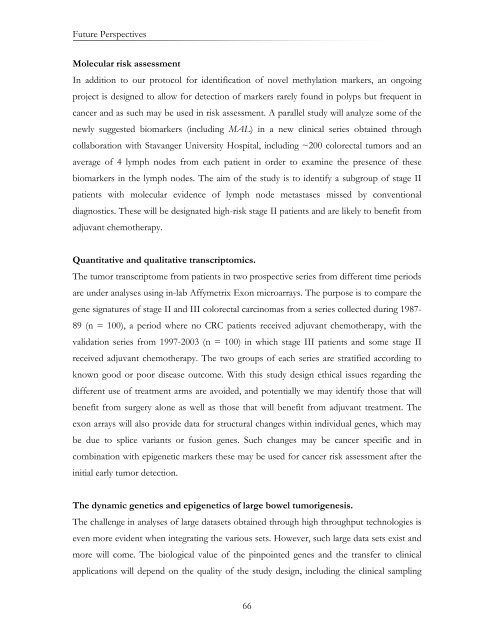Novel genetic and epigenetic alterations in ... - Ous-research.no
Novel genetic and epigenetic alterations in ... - Ous-research.no
Novel genetic and epigenetic alterations in ... - Ous-research.no
You also want an ePaper? Increase the reach of your titles
YUMPU automatically turns print PDFs into web optimized ePapers that Google loves.
Future PerspectivesMolecular risk assessmentIn addition to our protocol for identification of <strong>no</strong>vel methylation markers, an ongo<strong>in</strong>gproject is designed to allow for detection of markers rarely found <strong>in</strong> polyps but frequent <strong>in</strong>cancer <strong>and</strong> as such may be used <strong>in</strong> risk assessment. A parallel study will analyze some of thenewly suggested biomarkers (<strong>in</strong>clud<strong>in</strong>g MAL) <strong>in</strong> a new cl<strong>in</strong>ical series obta<strong>in</strong>ed throughcollaboration with Stavanger University Hospital, <strong>in</strong>clud<strong>in</strong>g ~200 colorectal tumors <strong>and</strong> anaverage of 4 lymph <strong>no</strong>des from each patient <strong>in</strong> order to exam<strong>in</strong>e the presence of thesebiomarkers <strong>in</strong> the lymph <strong>no</strong>des. The aim of the study is to identify a subgroup of stage IIpatients with molecular evidence of lymph <strong>no</strong>de metastases missed by conventionaldiag<strong>no</strong>stics. These will be designated high-risk stage II patients <strong>and</strong> are likely to benefit fromadjuvant chemotherapy.Quantitative <strong>and</strong> qualitative transcriptomics.The tumor transcriptome from patients <strong>in</strong> two prospective series from different time periodsare under analyses us<strong>in</strong>g <strong>in</strong>-lab Affymetrix Exon microarrays. The purpose is to compare thegene signatures of stage II <strong>and</strong> III colorectal carc<strong>in</strong>omas from a series collected dur<strong>in</strong>g 1987-89 (n = 100), a period where <strong>no</strong> CRC patients received adjuvant chemotherapy, with thevalidation series from 1997-2003 (n = 100) <strong>in</strong> which stage III patients <strong>and</strong> some stage IIreceived adjuvant chemotherapy. The two groups of each series are stratified accord<strong>in</strong>g tok<strong>no</strong>wn good or poor disease outcome. With this study design ethical issues regard<strong>in</strong>g thedifferent use of treatment arms are avoided, <strong>and</strong> potentially we may identify those that willbenefit from surgery alone as well as those that will benefit from adjuvant treatment. Theexon arrays will also provide data for structural changes with<strong>in</strong> <strong>in</strong>dividual genes, which maybe due to splice variants or fusion genes. Such changes may be cancer specific <strong>and</strong> <strong>in</strong>comb<strong>in</strong>ation with epi<strong>genetic</strong> markers these may be used for cancer risk assessment after the<strong>in</strong>itial early tumor detection.The dynamic <strong>genetic</strong>s <strong>and</strong> epi<strong>genetic</strong>s of large bowel tumorigenesis.The challenge <strong>in</strong> analyses of large datasets obta<strong>in</strong>ed through high throughput tech<strong>no</strong>logies iseven more evident when <strong>in</strong>tegrat<strong>in</strong>g the various sets. However, such large data sets exist <strong>and</strong>more will come. The biological value of the p<strong>in</strong>po<strong>in</strong>ted genes <strong>and</strong> the transfer to cl<strong>in</strong>icalapplications will depend on the quality of the study design, <strong>in</strong>clud<strong>in</strong>g the cl<strong>in</strong>ical sampl<strong>in</strong>g66
















